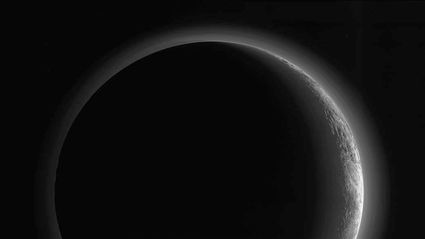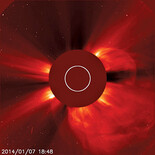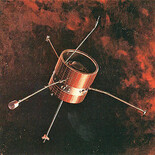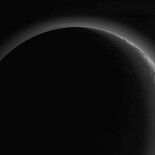New Horizons Changes Course as Pioneer 6 reaches 50

NASA
Pioneer 6 and its fellows are testaments to the scientific genius and technical prowess of the people armed with slide rules and vacuum tubes who got us off the ground and into space.
After dazzling the world with high resolution images and high-tech data from Pluto, New Horizons is going for the extra point. Even while it continued the slow process of downloading the massive store of data it gathered at Pluto, New Horizons changed course for yet another Kuiper Belt object (KBO) called 2014 MU69.
Surely there will be an initiative to give it a snazzier name! I'd like to start the bidding with "Rupert" from a fictional KBO in the Hitchhiker's Guide to the Galaxy.
Orbiting the sun more that a billion miles beyond Pluto, it will take over 37 months for New Horizons to reach Rupert. If NASA Headquarters agrees to extend the mission and the fan belt holds out, we should be in for another great show in January of 2019. As of this writing, all spacecraft systems are said to be "healthy."
KBOs are large icy bodies that are believed to be remnants of the earliest days of the solar system's formation. Detailed knowledge from two different KBOs will no doubt help us gain key insights into that formation process.
The plan is to approach even closer than to Pluto. I look forward to those pictures!
Pioneer 6 Turns 50
NASA's longest surviving space probe, Pioneer 6, is now fifty years old. It was launched in December of 1965 as the first of four probes that would orbit the sun and provide us with a wide variety of data about the environment outside the earth's magnetic field, where Apollo astronauts would soon venture. They also proved concepts for satellite control, such as spinning, that are still important today.
Pioneer's 6 & 9 orbited inside the earth's orbit, while 7 & 8 orbited outside where the earth's magnetic field stretches far into space.
The missions were a great success (although the program was marred when a fifth probe was destroyed during launch). Although designed to last only six months, all of them lasted for many years (as with most NASA spacecraft). Their 1960's-era electronics proved very robust in the harsh solar radiation. Although Pioneer 9 failed in 1983, Pioneer's 7 & 8 were functional when last checked in 1995 and 1996, respectively; and when Pioneer 6 was called in 2000 to celebrate its 35th birthday, it was able answer back on its back-up transmitter. This retired electronics engineer would bet a C-note that it still can; so no more snarky remarks about vacuum tube technology!
NASA stopped listening to those Pioneers when it launched the Solar and Heliospheric Observatory (SOHO), Pioneer's far more sophisticated successor. This full-blown solar observatory enters its 20th year of service this December. Built in Europe and launched by Lockheed Martin, this NASA-European Space Agency (ESA) collaboration has yielded invaluable information about the sun's interior, sunspots, the corona, and the solar wind. SOHO is importantly something of a solar weather ship that watches for solar flares and coronal mass ejections -- solar belches, if you will -- that can disrupt or damage satellites, affect GPS reliability, and even disrupt electrical grids on the earth's surface. It also has a knack for finding comets, having spotted its 3000th last September. The spacecraft is still going strong after twenty years without an oil change. If only they could build a car like that...(yes, well it might cost a bit much.) To learn more about this remarkable piece of technology, go to http://www.nasa.gov/mission_pages/soho.
Almanac
The weather has turned decidedly wintry already, with snow covering the surrounding mountains as I write. However, the sky is dazzlingly clear! That's the tradeoff with winter: Iffy weather, cold temperatures, but outstanding seeing when the clouds part. If you're up to it and can catch a break in the weather, there's plenty to see in our December sky.
This month, the best action is in the morning hours. The show includes plenty of planets, meteors, and even a new comet.
The bright planets all pop up before the sun. Jupiter starts the procession at about midnight, followed by Mars a couple of hours later. (Keep an eye on Mars, though--in May it will make a close pass and be at its biggest and brightest since 2005.) Venus rises about three hours before the sun. By mid-month, we'll also start to see Saturn emerging from the morning twilight.

NASA/JHUAPL/SWRI
Pluto as New Horizons looked back toward the sun. Taken only 15 minutes after its closest approach point, this wide-angle image clearly captures the dwarf planet's tenuous nitrogen atmosphere and its deep oceans of ice. In black & white, Pluto doesn't look all that different from Earth!
Keep an eye on Venus and Saturn; they're going to make a very close pass on January 9th.
The Geminid meteor shower should put on a fine show the nights of Dec.13-14 & 14-15. As usual, the best viewing is from midnight until dawn. But, with no moon to spoil things, it should be worth it. Just wrap up warm and keep the hot chocolate (or coffee, toddy...) coming! I also find a partner a great help in keeping my eyes open.
Comet Catalina (C/2013 US10 if you must) will be heading north across our eastern sky in the morning well into January as it flies away from the sun. It was discovered two years ago by the University of Arizona's Catalina Sky Survey. It seems that this is its first trip to the sun, so it may be full of surprises. Look for it to approach the bright star Arcturus from the south on New Years Day.
Sunrise/Sunset: 6:44 a.m./4:42 p.m. (December 1st) Tertiary







